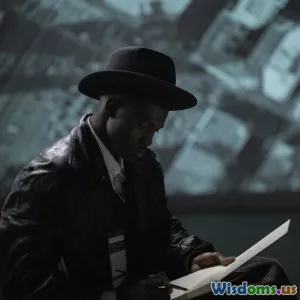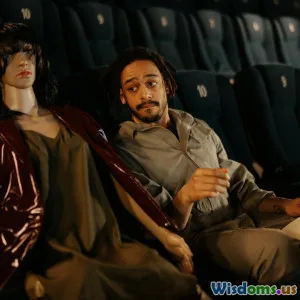
The Art of Film Editing: Crafting the Narrative
8 min read Explore the transformative craft of film editing and how editors shape cinematic narratives. (0 Reviews)
The Art of Film Editing: Crafting the Narrative
Film editing is often called the "invisible art"—a craft fundamental to storytelling yet rarely recognized by casual viewers. Editors manipulate raw footage, shaping scenes into a seamless narrative that engages, excites, and moves audiences. The skillful joining of shots transforms disconnected clips into emotional journeys and memorable cinematic experiences.
Introduction: The Editor’s Silent Brushstroke
Imagine watching a movie on fast forward—or one where scenes are out of order and the story feels jumbled. The experience would feel chaotic and unengaging. Film editors are the storytellers behind the story, controlling pacing, rhythm, and mood to build immersive worlds. They sculpt narrative structures as profoundly as a painter molds a canvas. But what makes their art so vital?
Film editing is more than piecing together footage; it’s about creating meaning. Every cut, transition, and assembly conveys subtext and emotion, influencing what viewers feel and understand. From the pulse-pounding chase sequences in "Mad Max: Fury Road" to the tender, lingering shots in "Call Me By Your Name," editing shapes audience perception and craft the narrative in unique ways.
The Foundations of Film Editing
Understanding Narrative Flow
At its core, film editing organizes story elements into a temporal flow that audiences can follow. Editor Walter Murch, famed for films like "Apocalypse Now," emphasized editing as a language of "finding the point of maximum storytelling impact with minimum footage." This means editors decide not only what's shown, but also when and how.
For instance, consider the role of cutting in Alfred Hitchcock’s suspense method. In Psycho’s iconic shower scene, editor George Tomasini expertly alternates quick cuts on closeups of the victim, the knife, and the attacker’s shadow, crafting tension that turns a simple scene terrifying without overly graphic imagery.
Pace and Rhythm
Film editing often parallels musical rhythm, where timing of cuts feels like beats in a composition. Varied pacing can heighten excitement or encourage reflection. The rapid editing during the climax of "The Bourne Ultimatum" immerses viewers in chaos and intensity, while the gentle long takes of Terrence Malick’s movies encourage contemplation.
Editors work meticulously to balance shots, giving viewers visual breathing room or boosting adrenaline. Software advancements enable greater speed and precision, but the underlying artistry of selecting where to cut remains a deeply intuitive process.
The Invisible Art: Continuity Editing
Continuity editing creates a smooth, seamless narrative flow that lets viewers remain absorbed without distraction. Techniques like the 180-degree rule preserve spatial orientation between shots. Jump cuts are minimized unless intentionally used for stylistic effect.
Classic filmmakers like D.W. Griffith pioneered continuity editing to structure modern cinematic language. When done well, editing feels invisible—evident only in how effortlessly audiences decipher the storyline.
How Editors Shape the Narrative
Constructing Emotional Arcs
Editors not only assemble scenes but also weave emotional highs and lows through selective cutting. For example, in "Eternal Sunshine of the Spotless Mind," editor Valdís Óskarsdóttir weaves fragmented memory sequences to mimic the psychological disintegration of the protagonist's mind, thus engaging the audience empathetically.
Manipulating Time and Space
Editing allows filmmakers to manipulate temporal and spatial relationships. Flashbacks, cross-cutting (interweaving parallel action), and montage all rely on editorial decisions.
In "The Godfather", the baptism scene cuts between a holy sacrament and violent assassinations, juxtaposing innocence and corruption. This masterful editing by William Reynolds underscores theme and character development without additional dialogue.
Enhancing Performance and Dialogue
Editors often refine actors’ performances by selecting takes with subtle gestures or enhanced emotional impact. The perfect reaction shot or timing pause can elevate a scene's impact. For example, the deft editing in "12 Angry Men" helps sustain mounting tension through patient interplay of closeups and group shots.
Technology Meets Creativity
From Moviola to Non-Linear Editing Systems
Historically, editors used physical film strips and Moviola machines to splice scenes by hand. The digital revolution introduced non-linear editing software like Avid Media Composer and Adobe Premiere Pro, vastly accelerating incubation of creative ideas.
However, technology facilitates but doesn't replace human judgment. Editing choices remain highly subjective, often requiring collaborative dialogue among directors, editors, and even test audiences.
Data-Driven Insights and AI?
Modern tools also analyze viewer engagement, informing editors about scene performance or emotional impact. Although AI offers editing assistance, the nuanced art of story shaping is still uniquely human, as creativity and intuition resist automation.
Legendary Film Editors: Crafting Cinema Classics
Editors like Thelma Schoonmaker (Martin Scorsese’s longtime collaborator), Dede Allen ("Bonnie and Clyde"), and Sally Menke (Quentin Tarantino’s editor) have earned acclaim for their visionary crafting of legendary films.
Schoonmaker’s work on "Raging Bull" is notable for dramatic speed shifts and juxtaposed shots that elevate the volatile nature of the story. Such editors influence storytelling at a fundamental level, altering cinema history through their craft.
Conclusion: The Invisible Author of Stories
Film editing is storytelling distilled—the moment-to-moment decision-making that determines how audiences perceive a film’s narrative, mood, and emotional depth. Editors are the architects of cinematic time and rhythm, who transform raw frames into compelling narratives.
By appreciating film editing, audiences gain insight into the silent storytelling layer that shapes films so powerfully. Aspiring filmmakers and cinephiles alike will find inspiration and understanding by studying this vital art form.
In the end, every cut, every transition, every pacing choice echoes the editor’s artistic imprint, the invisible brushstroke behind the magic of movies.
References
- Murch, Walter. In the Blink of an Eye: A Perspective on Film Editing. 2nd Edition. 2001.
- Interviews with Thelma Schoonmaker, Dede Allen.
- Bordwell, David, and Kristin Thompson. Film Art: An Introduction. 2019.
- Insights from American Cinematographer archives.
Rate the Post
User Reviews
Popular Posts


















